Influences of Optical Factors on the Performance of the Solar Furnace
Abstract
1. Introduction
2. Structure Design
3. Methods
- Incidence sunlight is treated as an optic cone.
- Heliostat facets are perfect flat surfaces.
- Concentrator facets are perfect curved surfaces.
- The center of the facets on the faceted concentrator is located at the point on a continuous revolution paraboloid with the equivalent focal distance.
- All traced solar rays have equal solar energy regardless of the angles of incidence.
3.1. Sun Position Tracking
3.2. Optical System Models
3.3. Heat Flux Calculation
4. Results and Discussion
4.1. Validation for the MCRT Model
4.2. Tilt Error of the Heliostat
4.3. Slope Error of the Concentrator
4.4. Layout Error of the Concentrator
4.5. Tilt Error of Concentrator
4.6. Comprehensive Factor Influence
- In terms of simulation, the MCRT model mainly consider optical factors caused by facets, not including the heliostat tracking error, the pillar tilting, environmental factors, etc. The actual situation is impossible to be exactly duplicated. Therefore, there must be differences between the simulation and the experiment.
- The experimental measurement procedure is as follows: A CCD camera captures the spot on the Lambertian intercepted surface and outputs the greyscale image. The heat flux result is then exported by comparing to the dependence of brightness and grey value on the standard point where a microsensor real-time measuring. The accuracy of the measurement strongly depends on the microsensor’s calibration. Thus, the accuracy of the experimental results may also be open to question.
- The difference in results between the experiment and the simulation, in the other aspect, also indicates that the comprehensive influence from various factors has an obvious impact on the overall operating performance of solar furnace. The key to a higher optical behavior is controlling each error well within the allowable range.
5. Conclusions
- The tilt error of heliostat affects the non-parallelism degree of the reflected sunlight. As the error increases, both the concentrated heat flux distribution and spot are diverging.
- The FEM is used to obtain the curved surface of concentrator facet. The slope error of the concentrator causes the mirror unit to become no longer an ideal surface, but rather complex and irregular under constraints. The error in the 1~2 mm could greatly reduce the concentration ability.
- The layout error occurs when facets attached to the concentrator frame share a similar curvature. Its existence will not enlarge the influence of the slope error.
- The tilt error of concentrator facets directly impacts on the focusing effect. As the tilt error increases in a certain direction, heat flux along the direction is scattering, while the orthogonal direction keeps in the Gaussian shape, but overall value decreases.
Author Contributions
Funding
Acknowledgments
Conflicts of Interest
Appendix A
References
- Trefilov, V.; Schur, D.; Pishuk, V.; Zaginaichenko, S.; Choba, A.; Nagornaya, N. The solar furnaces for scientific and technological investigation. Renew. Energy 1999, 16, 757–760. [Google Scholar] [CrossRef]
- Oliveira, F.A.C.; Fernandes, J.C.; Badie, J.-M.; Granier, B.; Rosa, L.G.; Shohoji, N. High meta-stability of tungsten sub-carbide W2C formed from tungsten/carbon powder mixture during eruptive heating in a solar furnace. Int. J. Refract. Met. Hard Mater. 2007, 25, 101–106. [Google Scholar] [CrossRef]
- Villafán-Vidales, H.; Arancibia-Bulnes, C.; Riveros-Rosas, D.; Romero-Paredes, H.; Estrada, C. An overview of the solar thermochemical processes for hydrogen and syngas production: Reactors, and facilities. Renew. Sustain. Energy Rev. 2017, 75, 894–908. [Google Scholar] [CrossRef]
- Guillot, E.; Rodriguez, R.; Boullet, N.; Sans, J.-L. Some details about the third rejuvenation of the 1000 kWth solar furnace in Odeillo: Extreme performance heliostats. AIP Conf. Proc. 2018, 2033, 040016. [Google Scholar]
- Abdurakhmanov, A.A.; Zainutdinova, K.K.; Mamatkosimov, M.A.; Paizullakhanov, M.S.; Saragoza, G. Solar technologies in Uzbekistan: State, priorities, and perspectives of development. Appl. Sol. Energy 2012, 48, 84–91. [Google Scholar] [CrossRef]
- Rodriguez, J.; Cañadas, I.; Zarza, E. New PSA high concentration solar furnace SF40. AIP Conf. Proc. 2016, 1734, 070028. [Google Scholar]
- Lee, H.; Chai, K.; Kim, J.; Lee, S.; Yoon, H.; Yu, C.; Kang, Y. Optical performance evaluation of a solar furnace by measuring the highly concentrated solar flux. Energy 2014, 66, 63–69. [Google Scholar] [CrossRef]
- Zhang, X.; Cui, Z.; Zhang, J.; Bai, F.; Wang, Z. Optical performance analysis of an innovative linear focus secondary trough solar concentrating system. Front. Energy 2018, 13, 590–596. [Google Scholar] [CrossRef]
- Riveros-Rosas, D.; Herrera-Vázquez, J.; Pérez-Rábago, C.; Bulnes, C.A.A.; Vázquez-Montiel, S.; Sanchez-Gonzalez, M.; Granados-Agustín, F.; Jaramillo, O.; Estrada, C.; Jaramillo, O. Optical design of a high radiative flux solar furnace for Mexico. Sol. Energy 2010, 84, 792–800. [Google Scholar] [CrossRef]
- Neumann, A.; Groer, U. Experimenting with concentrated sunlight using the DLR solar furnace. Sol. Energy 1996, 58, 181–190. [Google Scholar] [CrossRef]
- Jafrancesco, D.; Sansoni, P.; Francini, F.; Contento, G.; Cancro, C.; Privato, C.; Graditi, G.; Ferruzzi, D.; Mercatelli, L.; Sani, E.; et al. Mirrors array for a solar furnace: Optical analysis and simulation results. Renew. Energy 2014, 63, 263–271. [Google Scholar] [CrossRef]
- Ballestrín, J.; Monterreal, R. Hybrid heat flux measurement system for solar central receiver evaluation. Energy 2004, 29, 915–924. [Google Scholar] [CrossRef]
- Li, Z.; Tang, D.; Du, J.; Li, T. Study on the radiation flux and temperature distributions of the concentrator—Receiver system in a solar dish/Stirling power facility. Appl. Therm. Eng. 2011, 31, 1780–1789. [Google Scholar] [CrossRef]
- Zhao, D.; Xu, E.; Wang, Z.; Yu, Q.; Xu, L.; Zhu, L. Influences of installation and tracking errors on the optical performance of a solar parabolic trough collector. Renew. Energy 2016, 94, 197–212. [Google Scholar] [CrossRef]
- Shuai, Y.; Xia, X.-L.; Tan, H.-P. Radiation performance of dish solar concentrator/cavity receiver systems. Sol. Energy 2008, 82, 13–21. [Google Scholar] [CrossRef]
- Zou, B.; Dong, J.; Yao, Y.; Jiang, Y. A detailed study on the optical performance of parabolic trough solar collectors with Monte Carlo Ray Tracing method based on theoretical analysis. Sol. Energy 2017, 147, 189–201. [Google Scholar] [CrossRef]
- Bonanos, A.M. Error analysis for concentrated solar collectors. J. Renew. Sustain. Energy 2012, 4, 063125. [Google Scholar] [CrossRef]
- Meyen, S.; Lupfert, E.; DLR Gernam Aerospace Center; Ciemat, A.F.-G.; Nrel, C.K. Standardization of Solar Mirror Reflectance Measurements—Round Robin Test; National Renewable Energy Lab. (NREL): Golden, CO, USA, 2010.
- Meyen, S.; Lüpfert, E.; Pernpeintner, J.; Fend, T.; Schiricke, B. Optical Characterization of Reflector Material for Concentrating Solar Power Technology. In SolarPaces Conference. 2009. Available online: https://www.google.com/url?sa=t&rct=j&q=&esrc=s&source=web&cd=1&ved=2ahUKEwir9tCr55_lAhVnzIsBHV8eD48QFjAAegQIAhAC&url=http%3A%2F%2Felib.dlr.de%2F61684%2F1%2FSolarPaces2009_Mirror-Characterisation.pdf&usg=AOvVaw29cvWfKwbxWpYCBZeAaa_f (accessed on 15 October 2019).
- Guo, M.; Wang, Z.; Zhang, J.; Sun, F.; Zhang, X. Accurate altitude—Azimuth tracking angle formulas for a heliostat with mirror—Pivot offset and other fixed geometrical errors. Sol. Energy 2011, 85, 1091–1100. [Google Scholar] [CrossRef]
- Wang, F.; Bai, F.; Wang, T.; Li, Q.; Wang, Z. Experimental study of a single quartz tube solid particle air receiver. Sol. Energy 2016, 123, 185–205. [Google Scholar] [CrossRef]
- Ma, L.; Wang, Z.; Lei, D.; Xu, L. Establishment, Validation, and Application of a Comprehensive Thermal Hydraulic Model for a Parabolic Trough Solar Field. Energies 2019, 12, 3161. [Google Scholar] [CrossRef]
- Duffie, J.A.; Beckman, W.A. Solar Engineering of Thermal Processes; Wiley: Hoboken, NJ, USA, 2013; p. 23. [Google Scholar]
- Xu, Y.; Cui, K.; Liu, D. The development of a software for solar radiation and its verification by the measurement results on the spot. Energy Technol. 2002, 23, 237–239. [Google Scholar]
- Evans, D. On the performance of cylindrical parabolic solar concentrators with flat absorbers. Sol. Energy 1977, 19, 379–385. [Google Scholar] [CrossRef]
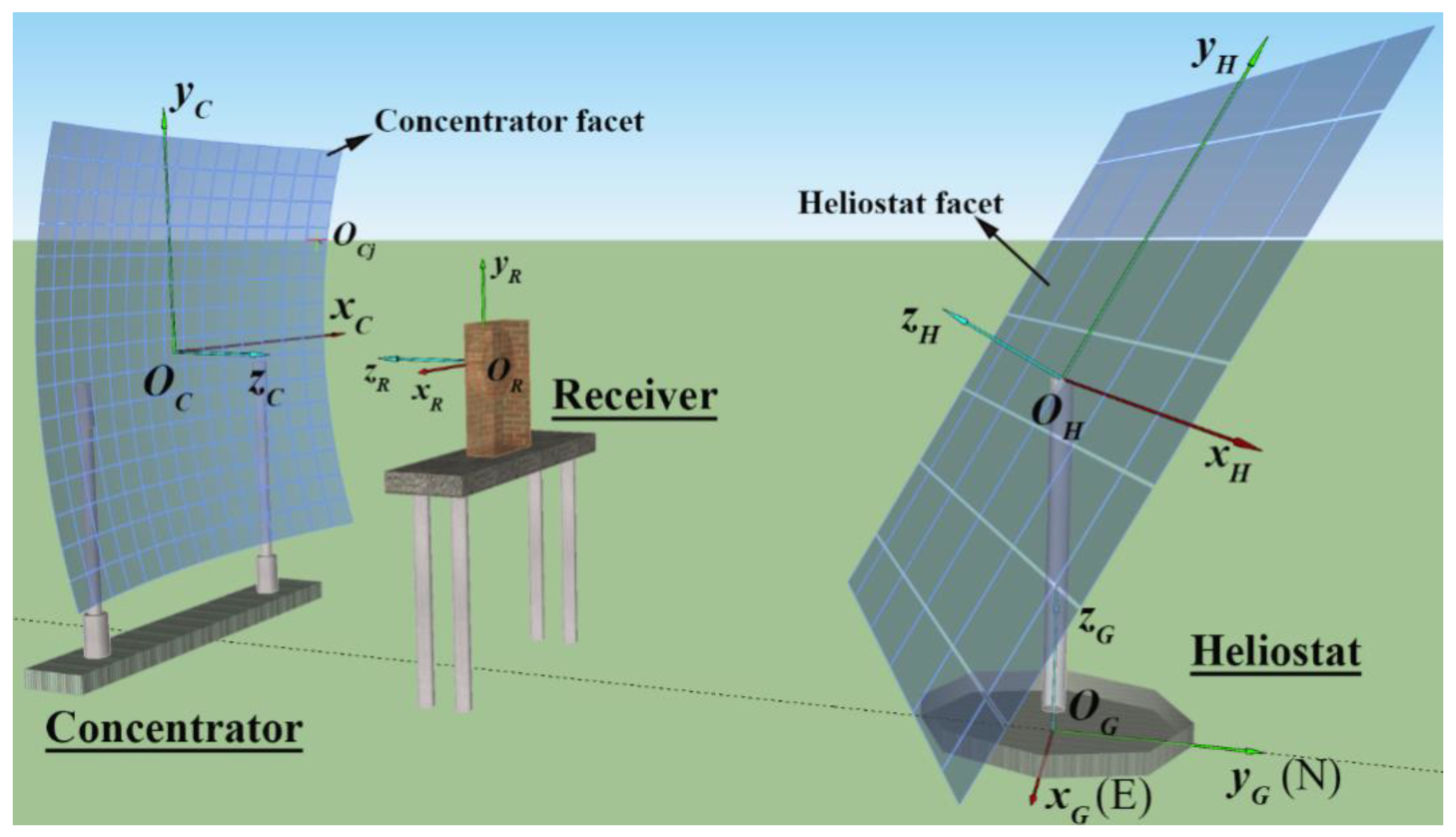
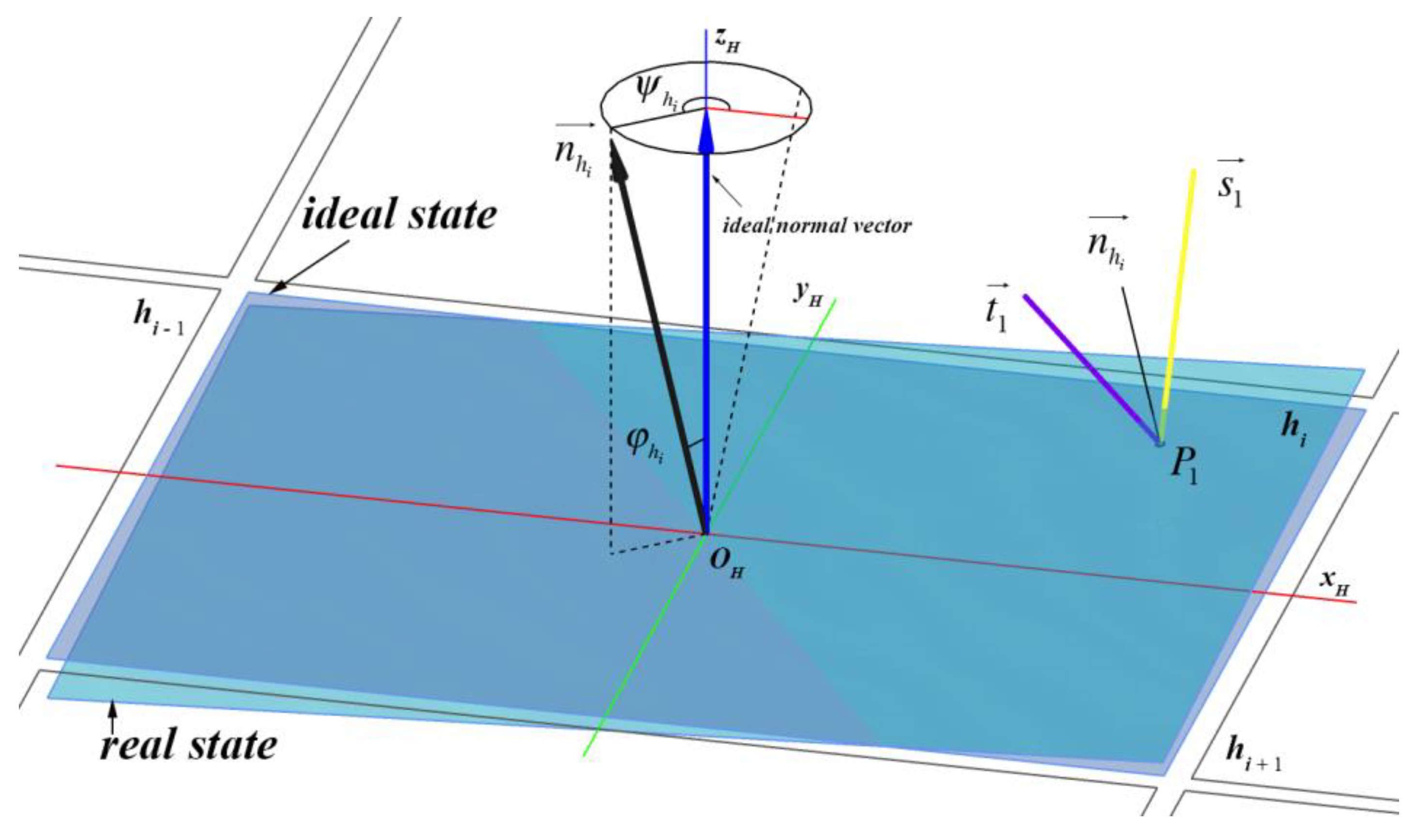



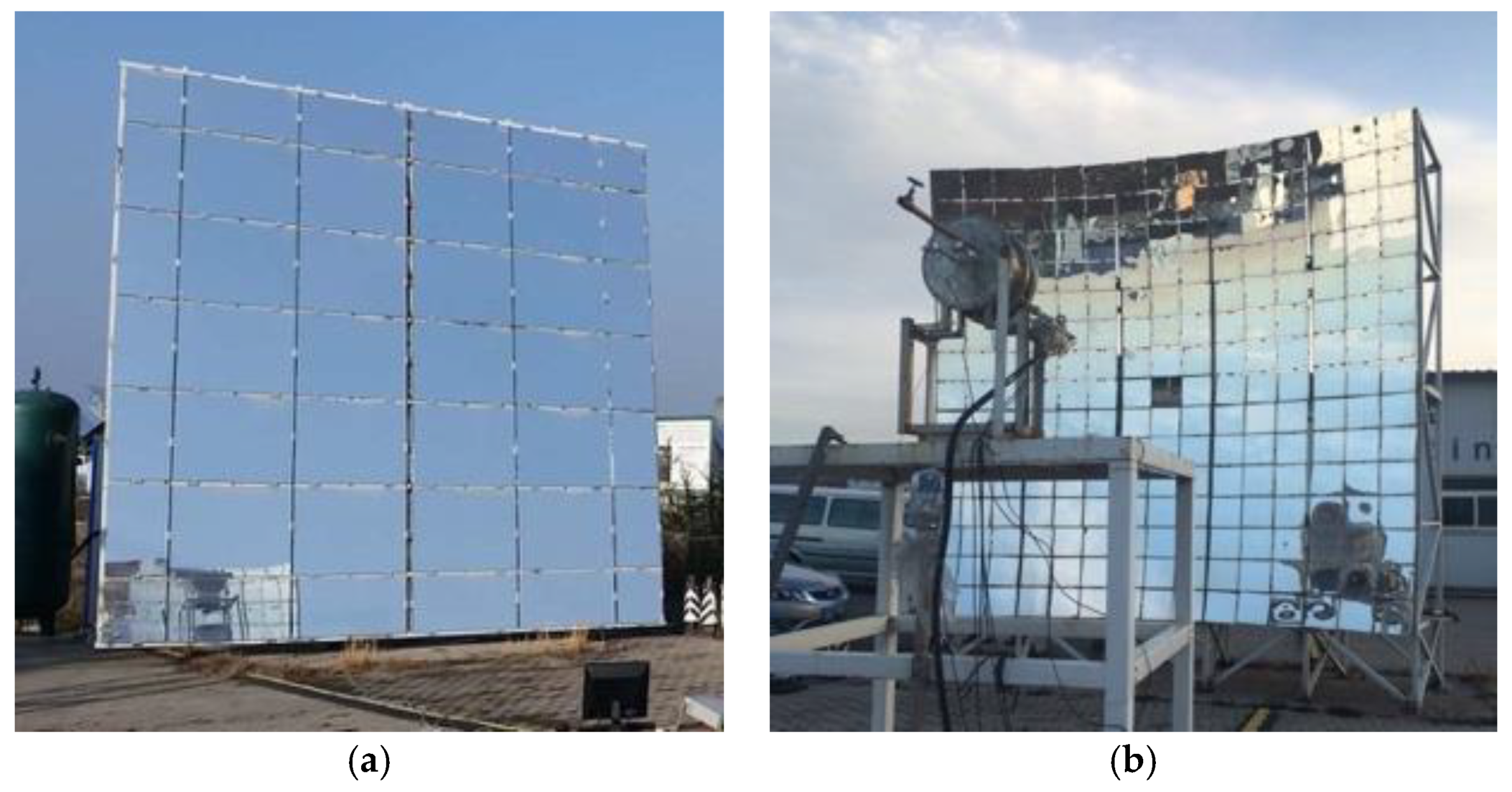
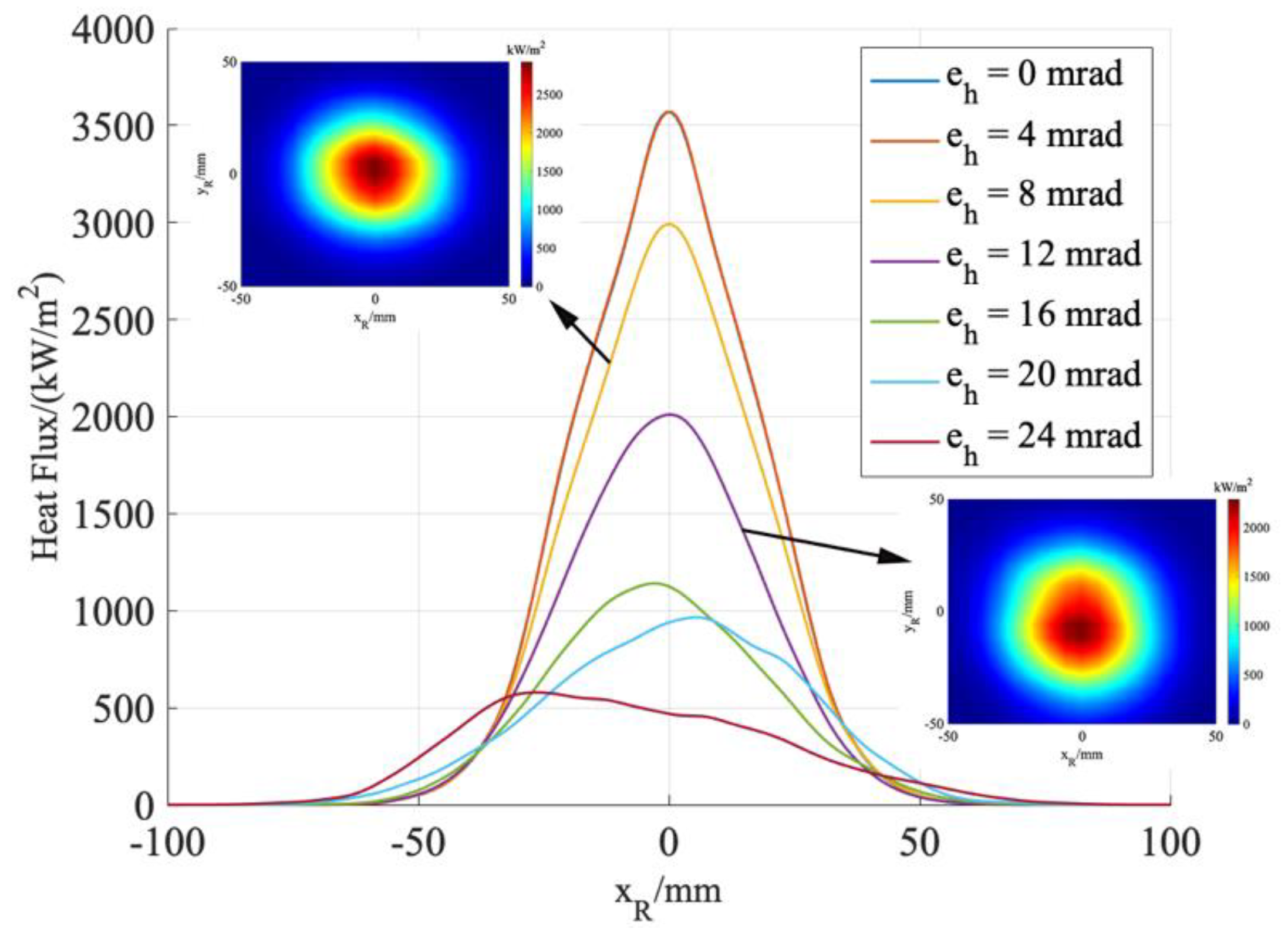
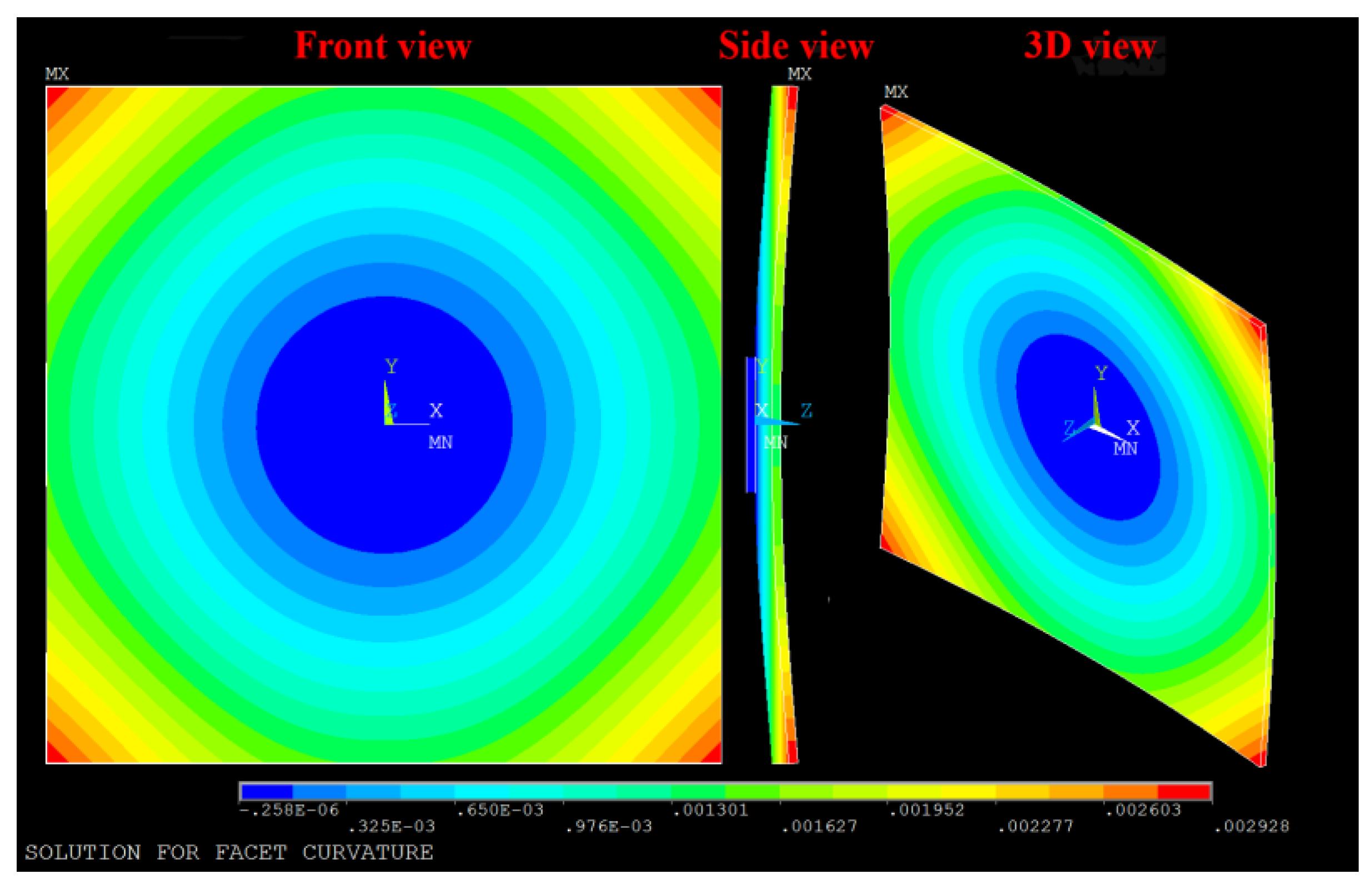


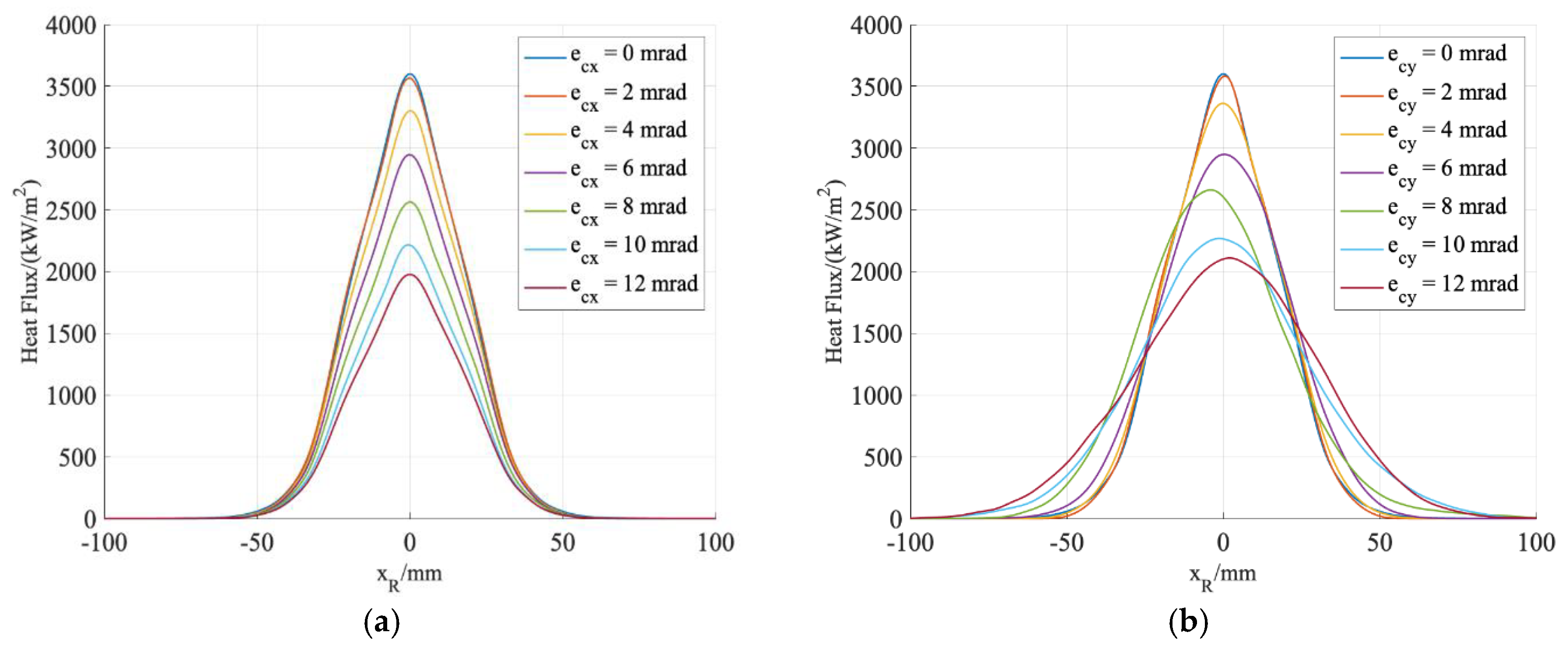
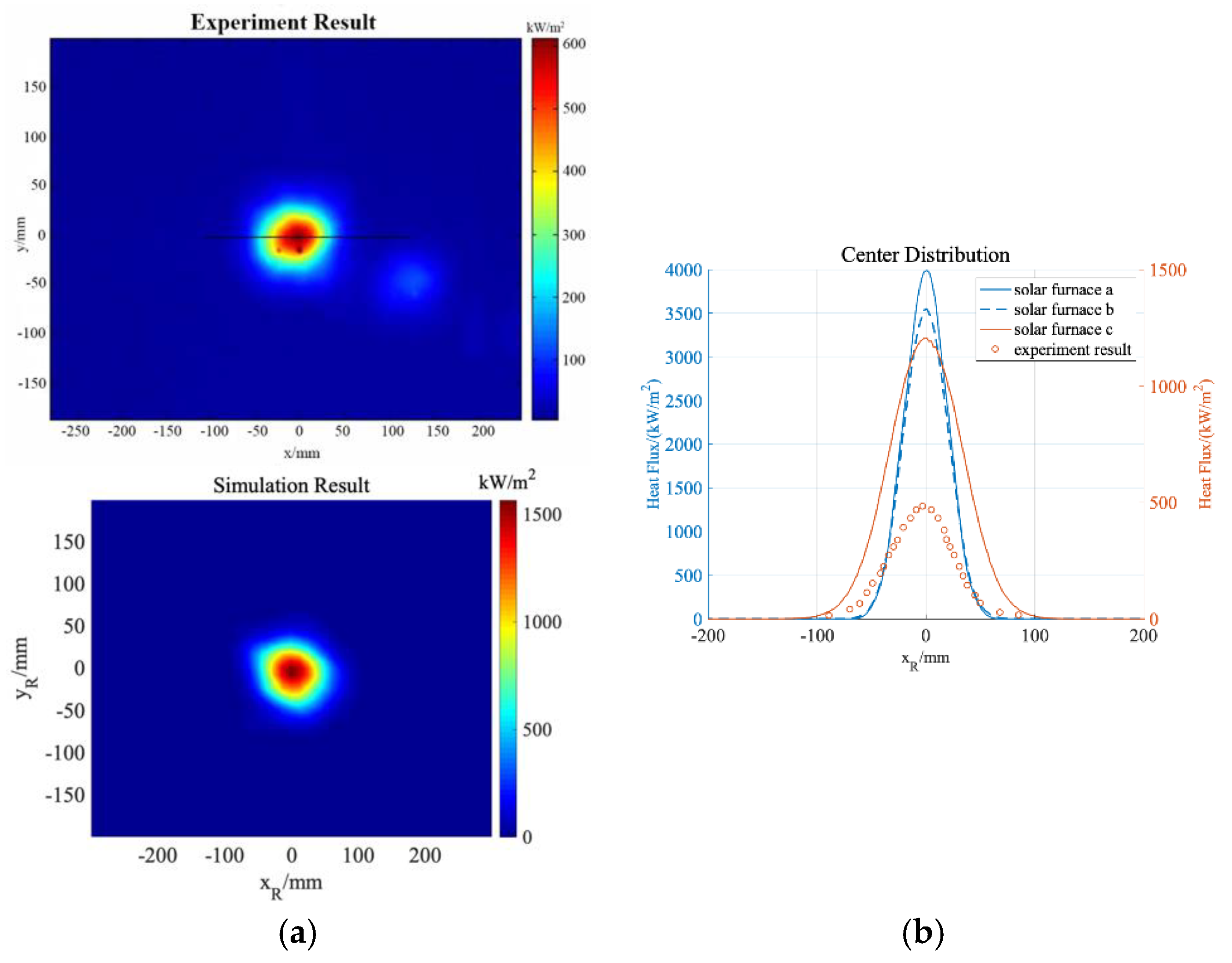
| Name | Values |
|---|---|
| (mrad) | 4.7 |
| Heliostat (m × m) | 12 × 10 |
| Radius of the Circular of the Paraboloid Concentrator (m) | 4 |
| Focal Length (m) | 15.512 |
| DNI (W/m2) | 970 |
| 0.9 | |
| 0.9 |
| Name | Size (m × m) | Row & Column | Gap (mm) | Focal Length (m) |
|---|---|---|---|---|
| Heliostat | 6.250 × 5.975 | 7 × 6 | 30 | 3.8 |
| Concentrator | 4.572 × 4.572 (Aperture) | 15 × 15 | 10 |
| Name | Values |
|---|---|
| Diameter of connecting pad (mm) | 600 |
| Facet mirror thickness (mm) | 4 |
| Density (kg/m3) | 2800 |
| Young’s modulus (GPa) | 75 |
| Poisson ratio | 0.25 |
| Name | Displacements of the Adjusting Bolts (mm) | |||||||
|---|---|---|---|---|---|---|---|---|
| 1 | 2 | 3 | 4 | 5 | 6 | 7 | 8 | |
| Facet a | 2.58 | 1.29 | 2.58 | 1.29 | 2.58 | 1.29 | 2.58 | 1.29 |
| Facet b | 3.00 | 1.50 | 3.00 | 1.50 | 3.00 | 1.50 | 3.00 | 1.50 |
| Facet c | 2.60 | 1.20 | 2.60 | 1.20 | 2.60 | 1.20 | 2.60 | 1.20 |
| Facet d | 2.80 | 1.80 | 2.50 | 1.00 | 3.50 | 0.80 | 2.20 | 1.20 |
| Facet e | An ideal revolution paraboloid with a focal distance of 3.8 m | |||||||
| Name | Tilt Error in Heliostat | Tilt Error in Concentrator | Concentrator Facet |
|---|---|---|---|
| Solar furnace a | , | Facet a | |
| Solar furnace b | , | Facet a | |
| Solar furnace c | , | Facet a |
© 2019 by the authors. Licensee MDPI, Basel, Switzerland. This article is an open access article distributed under the terms and conditions of the Creative Commons Attribution (CC BY) license (http://creativecommons.org/licenses/by/4.0/).
Share and Cite
Cui, Z.; Bai, F.; Wang, Z.; Wang, F. Influences of Optical Factors on the Performance of the Solar Furnace. Energies 2019, 12, 3933. https://doi.org/10.3390/en12203933
Cui Z, Bai F, Wang Z, Wang F. Influences of Optical Factors on the Performance of the Solar Furnace. Energies. 2019; 12(20):3933. https://doi.org/10.3390/en12203933
Chicago/Turabian StyleCui, Zhiying, Fengwu Bai, Zhifeng Wang, and Fuqiang Wang. 2019. "Influences of Optical Factors on the Performance of the Solar Furnace" Energies 12, no. 20: 3933. https://doi.org/10.3390/en12203933
APA StyleCui, Z., Bai, F., Wang, Z., & Wang, F. (2019). Influences of Optical Factors on the Performance of the Solar Furnace. Energies, 12(20), 3933. https://doi.org/10.3390/en12203933






